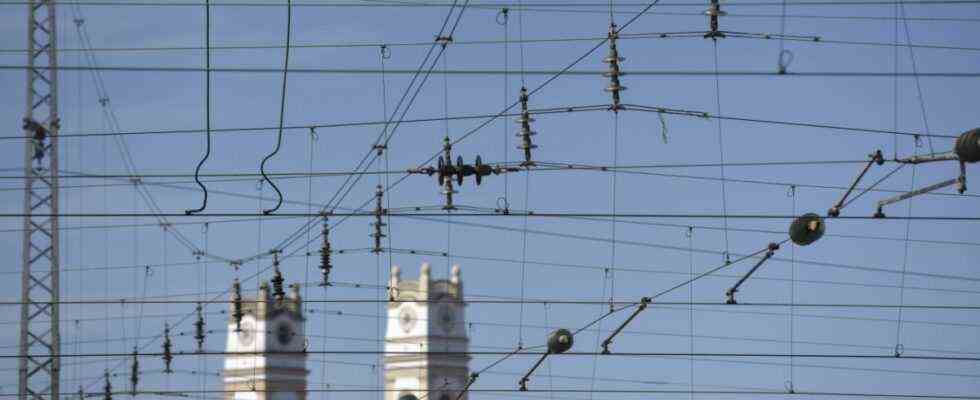Trains with electric drives can run on just 29 percent of all railway lines in Schleswig-Holstein. This means that one has “the red lantern” among the German federal states, says Andreas Tietze, Member of the Green Party. “I think that’s crazy.” And if his CDU colleague Lukas Kilian has his way, that should change quickly. “We all want electrification on every possible route,” says Kilian. Among other things, the important route from Itzehoe to Sylt, the so-called Marschbahn, is to be electrified. And the federal government has recently set itself major goals: by 2025, the proportion of electrified routes is to grow to 70 percent. A thoroughly ambitious goal, as experts say. Here are the most important questions and answers on the subject:
What is the current level of electrification?
According to the “Allianz Pro Schiene”, a lobby grouping among other things, rail unions and transport associations, this is currently 61 percent nationwide. For comparison: In Switzerland, an overhead contact line hovers over almost all rail lines, almost every train there is electric. India also recently announced that it intends to almost completely electrify its (broad-gauge) main network by 2023, and Belgium has achieved an electrification rate of 86 percent. “We are still a long way from such values in Germany,” says Andreas Geißler, an expert on the electrification of the rail network at Allianz Pro Schiene. In addition, only 27 of 57 rail border crossings are electrified.
Why is that?
“To make it short: the transport policy of the past decades,” says Geissler. Over the years, the federal and state governments have invested a lot of money in upgrading the road, neglecting the railways as a whole – also when it comes to electrification. According to Geißler, the proportion of electrified lines in the entire rail network has only grown by two percentage points over the past ten years – from 59 percent in 2010 to 61 percent today. According to the association’s calculations, an average of just 65 kilometers of railway line was provided with an overhead contact line per year.
And should that change now?
Yes. The federal government wants – for reasons of climate protection alone – to change course in transport policy and to rely more on the railways in the future, numerous (master) plans have recently been drawn up for this purpose. “This laid the conceptual foundations in the previous legislature,” says Geissler. The degree of electrification is expected to increase to 70 percent by 2025. Now, however, it is about implementing what has been decided, i.e. bringing what has been written out into the open. “And that will be a feat of strength,” emphasizes Geißler. Because in order to achieve the goal, an average of 570 kilometers of rail would have to be provided with an overhead line every year from now on – basically a nine-fold increase of what has been achieved annually so far.
What is hindering the expansion?
In the past, it was mainly the lack of financial resources that slowed the renewal of the railways, but now there is mainly a lack of the necessary planning. Because there was little money available in the end, the planners of the railway were only able to tackle a few routes – and now there are no concepts in the drawers that can simply be pulled out and implemented. “A lot of time has been wasted,” says Geissler. In addition, such planning takes a long time, among other things, residents and municipalities must be involved. In Schleswig-Holstein, State Transport Minister Bernd Buchholz (FDP) and his colleague from the Environment Department, Jan Philipp Albrecht (Greens), want to bring about a change in the law to speed up planning on the march. Under certain conditions, the planners should then be able to dispense with lengthy planning approval procedures.
Are there any other barriers?
In fact, many planning offices currently simply lack the necessary specialists to be able to implement the projects quickly. Civil engineers are desperately wanted, not only in the railways, but also in the road administration. And there is another point that troubles the transport industry: Because the construction industry is booming overall, it is becoming increasingly difficult to find companies that will ultimately carry out the planning.
What are the advantages of electrification?
In itself, a diesel train is far more energy-efficient than any truck or car – but it still emits pollutants and pollutes the climate by burning fossil fuels. Electric trains improve the balance here, especially since the proportion of sustainably generated energy in the traction current is growing continuously. The Kiel Green MP Tietze recently put it this way: In future, people will drive with “electricity from the dike instead of oil from the sheikh”. In addition: Electrically powered trains can accelerate faster and better, electric locomotives can also pull longer and heavier trains – which could increase capacities, especially in goods transport. Ultimately, the goal of the federal government is to increase the proportion of goods traffic by 2030 from around 19 percent now to 25 percent – this should, among other things, relieve the highways of truck traffic. And: Modern electric locomotives usually feed the energy gained during braking back into the network.
What about hydrogen and battery trains?
Corresponding tests are underway in several federal states, for example in Lower Saxony and Bavaria with local trains powered by hydrogen fuel cells or rechargeable batteries. Such approaches are promising, says Geissler, especially in local public transport in rural areas. Small and light multiple units are mostly used there, and the time-consuming equipping of lines with overhead lines is simply not worthwhile. In Schleswig-Holstein, for example, a little more than 50 battery trains are to run nationwide on branch lines in the future. In freight transport, however, where trains weighing several thousand tons roll across Europe, as well as on the heavily used passenger transport routes, there is basically no avoiding large-scale electrification of the routes, says Geissler.

